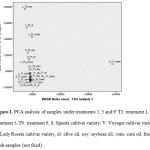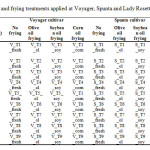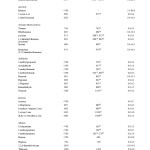Introduction
Potato chips are one of the most popular snacks worldwide. It is well-known that their acceptability is strongly influenced by their quality and hence their flavor is of increasing importance to consumers.
The aroma development in potato tubers is related to the high number of changes that occur during potato growth and heat-treatment (frying). There are a number of potential precursors responsible for the flavor, which may be produced by lipid hydrolysis and autoxidation, proteolysis and transformation of amino acids to aromatic compounds and carbohydrate metabolism. Therefore, several studies have been focused on the investigation of volatiles’ profile and sensory characteristics of potatoes.1,2 Identification of volatiles’ profile has been also used for characterizing the geographical origin3 and detecting the onset of disease.4,5 However, very little is known about the effect of organic fertilization, frying oil, as well as cultivar variety on the generation of aroma compounds.
Voyager, Spunta and Lady Roseta are considered among the most popular and widely consumed chipping varieties (http://varieties.ahdb.org.uk/). Voyager is a new long white potato variety, with excellent results for boiling, baking and French fries that boasts high yield potential. Spunta is a very conventional and well-known table potato, suitable for production in many climates. It produces big, long, slightly kidney-shaped tubers with a pale skin and light yellow flesh at high yields. Lady Rosetta is a specialist crisping variety, with high dry matters and low reducing sugars. Lady Rosetta comes from Holland from the crossing variety Cardinal X SVP (VTN2) 62-33-3. It is a premature variety and the tubers have a round shape, red epidermis and yellowish flesh. It has very high quality characteristics, is suitable for the production of potato chips and is very resistant to humidity.
Thus, the effect of organic fertilization on the volatile metabolic profile of potato tubers of three chipping varieties (Voyager, Spunta and Lady Rosetta) after frying with three different oils (olive oil, soybean and corn oil) was of interest in the present study.
 |
Figure 1: PCA analysis of samples under treatments 1, 5 and 9. Τ1: treatment 1, Τ5: treatment 5, Τ9: treatment 9, S: Spunta cultivar variety, V: Voyager cultivar variety, L: Lady Roseta cultivar variety, ol: olive oil, soy: soybean oil, corn: corn oil, fresh: fresh samples (not fried). Click here to View figure |
Materials and Methods
Treatments and samples
During cultivation of three potato cultivars (Voyager, Spunta and Lady Rosetta), the following nine treatments (T) involving the combination of nitrogen, phosphorus and potassium fertilization under organic farming were applied: T1: control treatment; T2: N1, P1, K1; T3: N1, P1, K2; T4: N1, P2, K1; T5: N1, P2, K2; T6: N2, P1, K1; T7: N2, P1 K2; T8: N2, P2, K1; and T9: N2, P2, K2, where Ν1=1.3 g Ν per plant; N2=2.0 g Ν per plant; P1=3.1 g P2O5 per plant; P2=5.2 g P2O5 per plant; Κ1= 4.0 g K2O per plant; and Κ2= 6.6 g K2O per plant (Table 1). Fertilization was performed by using the organic fertilizers PatentKali (containing 30 % potassium oxide (Κ2Ο), 10 % magnesium oxide (MgO) and 17 % sulphur), Agrobiosol (6 % total nitrogen, 0.5 % (P2O5), 0.5 % (Κ2Ο) and 85 % organic matter), Phosphorite (27 % (Ρ2Ο5) and Acadian (1 % nitrogen, 1 % phosphorus and 1 % potassium). Seed tubers were planted in 11-L pots containing a mixture 1:1 (vol/vol) of peat (pH=6, no additional inorganic nutrient elements) and perlite. Each treatment was applied to five replicates of four plants each and the experiments were carried out at the Technological Educational Institute of Peloponnese (Kalamata, Greece) between March and May 2013.
The potato tubers (250 g) were then fried using olive, soybean or corn oil at 180 ºC for 8 min.
HS-SPME GC/MS analysis
The SPME GC/MS analysis was carried out as described recently1 with some modifications. In brief, grated fresh or fried samples (≈4 g each) from all treatments (108 samples in total) were placed into a 20 mL head space vial fitted with a Teflon-lined septum sealed with an aluminum crimp seal, through which the SPME syringe needle (bearing a 2 cm fiber coated with 50/30 mm Divinylbenzene/Carboxen on poly-dimethyl-siloxane bonded to a flexible fused silica core, Supelco, Sigma-Aldrich, UK) was introduced. The container was thermostated at 70 oC for 20 min. The absorbed volatile analytes were then analyzed by GC/MS (6890N GC, 5973 Networked MS MSD, Αgilent Technologies, USA) using an HP-5MS column (30 m, 0.25 mm i.d., 0.25 μm film thickness). Helium was used as the carrier gas at a constant pressure of 70 kPa. Oven temperature was set at 40 oC for 1 min, followed by a temperature gradient of 20 oC/min to 120 oC, held for 8 min, then increased to 260 oC/min at a rate of 20 oC and held for 2 min. The injector was operated in splitless mode. Injector and detector temperatures were 260 oC. The mass spectrometer was operated in the electron impact mode with the electron energy set at 70 eV. Results were processed by ChemStation integrated software (Agilent Technologies). The identification was carried out by comparing the retention times and mass spectra of volatiles to those of authentic compounds generated in the laboratory (in-house libraries), by mass spectra obtained from NB575K, stack and Wiley275 libraries, and by determining Kovats’ retention indexes and comparing them with those reported in the literature. Kovats’ retention indexes were determined by injection of a standard mixture containing the homologous series of normal alkanes (C8-C24) in pure hexane under exactly the same experimental conditions, as described above. 4-methyl-2-pentanol diluted in pure ethanol was used as an internal standard (IS) at 0.8 mg/kg of sample. The volatile compounds were semi-quantified by dividing the peak areas of the compounds of interest by the peak area of the IS and multiplying this ratio by the initial concentration of the IS (expressed as mg/kg). The peak areas were measured from the full scan chromatograph using total ion current (TIC). Each experiment was carried out in duplicate and the mean data are presented (standard deviation for all values was about ±10% in most cases).
Statistical analysis
Principal component analysis (PCA) of data was computed using SPSS (v. 15.0).
Results and Discussion
The present study constitutes a preliminary investigation on the effect of organic fertilization, frying oil and cultivar variety on the volatile metabolic profile of potato tubers. The strategy adopted was to apply fertilization treatments during cultivation on three chipping potato varieties (Voyager, Spunta, and Lady Rosetta). Subsequently, the outcome of frying using three different oils (extra virgin olive, soybean or corn oil) separately on the profile of volatile compounds was monitored.
 |
Table 1: Samples, organic fertilization and frying treatments applied at Voyager, Spunta and Lady Rosetta potato cultivars. Click here to View table |
HS-SPME GC/MS analysis
For the evaluation of the aromatic profile, the fried potato tubers were analyzed using the HS-SPME GC/MS technique. In total, 108 duplicate samples were analyzed and 46 compounds were detected. The main volatile compounds identified were esters, alcohols, carbonyl compounds and hydrocarbons (Table 2).
Sugars, aminoacids and fatty acids are the major precursors of the volatile compounds formed when potatoes are cooked by various means. Esters, mainly the short chain acids, are responsible for fruity aromas and have been identified in oils, such as olive oil.1,6 Carbonyl compounds mainly result from a degradative reaction of lipid oxidation of unsaturated fatty acids, such as oleic, linoleic and linolenic acids, and contribute to reactions which yield volatile flavor compounds. In potato crisps unsaturated fatty acids may come from the oil used for frying.1 On the other hand, hydrocarbons have a less pronounced effect on potatoes’ flavor.
 |
Table 2: Volatiles identified in fresh and fried
|
Most of the compounds identified were also detected in previous studies. Ethyl acetate, ethanol, acetone, chloroform, heptane, toluene, ethyl benzene, p– and m-xylene, a-pinene and 1,3,5-trimethyl-benzene are usually present in potato tubers.7-9 Likewise, benzaldehyde, tridecane, hexadecane, 2-ethyl-1-hexanol, 2-methyl-butanal, and 3-methyl-butanal have been identified in Italian potatoes3 and in potatoes after microwave baking10 in addition to hexane, hexanal, heptanal, 2-heptenal, nonanal, 6-methyl-5-hepten-2-one and limonene. Of note, 2-ethyl-1-hexanol has been also found in significant amounts in the headspace of tubers deliberately infected by Phytophthora infestans and in Fusarium coeruleum-inoculated tubers.7 However, in our study, no such infection was noticed. Hexanal, heptanal, 2-heptenal, and nonanal may derive from oxidative degradation of unsaturated acids present in frying oils.11 These compounds contribute to the aroma of oxidised crisps, due to their low odour threshold and the content of hexanal, heptanal and nonanal is usually increased during storage.1,2 Alkylpyrazines, like 3-ethyl-2,5-dimethyl-pyrazine, are formed by the Maillard reaction.
Nevertheless, aroma perception in food products depends not only on the concentration and odour thresholds of volatile compounds, but also on their interactions with other food components and among volatile compounds.
Chemometrics
PCA is used in exploratory analysis, as it gives graphical representations of inter-sample and inter-variable relationships and provides a way to reduce the complexity of the data. PCA was considered as a suitable and valuable tool to identify potential significant effects due to the very high number of samples.
The results revealed that nitrogen fertilization affected the volatiles’ profile only when high fertilization of P2O5 and K2O was applied (treatments 5 and 9). As shown in Figure 1, samples under treatment 5 clearly distinguished from samples under treatments 1 or 9. These results were in accordance with a previous study,3 reporting that nitrogen can be used as an indicator of the geographical origin of potato, due to the different regional agricultural practices adopted and types of fertilizer used. No other effect or correlation was observed (data not shown).
Conclusions
In conclusion, the results indicated that mainly nitrogen fertilization rather than phosphorus and potassium fertilization or frying oil and potato variety may affect significantly the volatiles’ profile of potato chips. However, more research is still required to assess the role of each factor that might have a significant effect on the quality of fried potato tubers.
Acknowledgments
The work was funded by the European Social fund and National Resources through Research Program Archimedes III.
References
- Sanches-Silva, A., Lopez-Hernández, J., & Paseiro-Losada, P. (2005). Profiling flavor compounds of potato crisps during storage using solid-phase microextraction. Journal of Chromatography A, 1064(2), 239-245.
CrossRef - Lee, J. H., & Pangloli, P. (2011). Volatile compounds and storage stability of potato chips fried in mid-oleic sunflower oil. International Journal of Food Properties, 16(3), 563-573.
CrossRef - Longobardi, F., Casiello, G., Sacco, D., Tedone, L., & Sacco, A. (2011). Characterisation of the geographical origin of Italian potatoes, based on stable isotope and volatile compound analyses. Food Chemistry, 124(4), 1708-1713.
CrossRef - Blasioli, S., Biondi, E., Samudrala, D., Spinelli, F., Cellini, A., Bertaccini, A., Braschi, I. (2014). Identification of volatile markers in potato brown rot and ring rot by combined GC-MS and PTR-MS techniques: Study on in vitro and in vivo samples. Journal of Agricultural and Food Chemistry, 62(2), 337-347.
CrossRef - De Lacy, C., Evans, Ewen, Gunson, Ratcliffe, & Spencer, P. (1999). Identification of volatiles generated by potato tubers (Solanum tuberosum CV: Maris Piper) infected by Erwinia carotovora, Bacillus polymyxa and Arthrobacter sp. Plant Pathology, 48(3), 345-351.
CrossRef - Olias, J. M., Perez, A. G., Rios, J. J., & Sanz, L. C. (1993). Aroma of virgin olive oil: Biogenesis of the “green” odor notes. Journal of Agricultural and Food Chemistry, 41(12), 2368-2373.
CrossRef - De Lacy Costello, B. P. J., Evans, P., Ewen, R. J., Gunson, H. E., Jones, P. R. H., Ratcliffe, N. M., & Spencer-Phillips, P. T. N. (2001). Gas chromatography–mass spectrometry analyses of volatile organic compounds from potato tubers inoculated with Phytophthora infestans or Fusarium coeruleum. Plant Pathology, 50(4), 489-496.
CrossRef - Lui, L., Vikram, A., Hamzehzarghani, H., & Kushalappa, A. C. (2005). Discrimination of three fungal diseases of potato tubers based on volatile metabolic profiles developed using GC/MS. Potato Research, 48(1-2), 85-96.
CrossRef - Lui, L. H., Vikram, A., Abu-Nada, Y., Kushalappa, A. C., Raghavan, G. S. V., & Al-Mughrabi, K. (2005). Volatile metabolic profiling for discrimination of potato tubers inoculated with dry and soft rot pathogens. American Journal of Potato Research, 82(1), 1-8.
CrossRef - Oruna-Concha, M. J., Bakker, J., & Ames, J. M. (2002). Comparison of the volatile components of eight cultivars of potato after microwave baking. LWT – Food Science and Technology, 35(1), 80-86.
CrossRef - Belitz, H. D. and Grosch, W. 1987. Lipids. In Food Chemistry (Springer-Verlag Berlin: Heiderlberg, 128-200 pp.
- Baek, H. H., Cadwallader, K. R., Marroquin, E., & Silva, J. L. (1997). Identification of predominant aroma compounds in muscadine grape juice. Journal of Food Science, 62(2), 249-252.
CrossRef - Adams, R. P. (1995). Identification of essential oil components by gas chromatography/mass spectrometry. Allured Publishing Corporation, Carol Stream, IL. (pp. 1-550), USA.
- Engel, E., Baty, C., le Corre, D., Souchon, I., & Martin, N. (2002). Flavor-active compounds potentially implicated in cooked cauliflower acceptance. Journal of Agricultural and Food Chemistry, 50(22), 6459-6467.
CrossRef - Qian, M., & Reineccius, G. (2003). Potent aroma compounds in Parmigiano Reggiano cheese studied using a dynamic headspace (purge-trap) method. Flavour and Fragrance Journal, 18(3), 252-259.
CrossRef - Jirovetz, L., Buchbauer, G., Ngassoum, M. B., & Geissler, M. (2002). Aroma compound analysis of Piper nigrum and Piper guineense essential oils from Cameroon using solid-phase microextraction–gas chromatography, solid-phase microextraction–gas chromatography–mass spectrometry and olfactometry. Journal of Chromatography A, 976(1–2), 265-275.
CrossRef - Pino, J. A., Mesa, J., Muñoz, Y., Martí, M. P., & Marbot, R. (2005). Volatile components from mango (Mangifera indica L.) cultivars. Journal of Agricultural and Food Chemistry, 53(6), 2213-2223.
CrossRef - Pino, J. A., & Quijano, C. E. (2012). Study of the volatile compounds from plum (Prunus domestica L. cv. Horvin) and estimation of their contribution to the fruit aroma. Food Science and Technology (Campinas), 32, 76-83.
CrossRef - Lubeck, A. J., & Sutton, D. L. (1983). Kovats retention indices of selected hydrocarbons through C10 on bonded phase fused silica capillaries. Journal of High Resolution Chromatography, 6(6), 328-332.
CrossRef - Wang, Z., Fingas, M., & Li, K. (1994). Fractionation of a light crude oil and identification and quantitation of aliphatic, aromatic, and biomarker compounds by GC-FID and GC-MS, Part II. Journal of Chromatographic Science, 32(9), 367-382.
CrossRef - Zehentbauer, G., & Reineccius, G. A. (2002). Determination of key aroma components of Cheddar cheese using dynamic headspace dilution assay. Flavour and Fragrance Journal, 17(4), 300-305.
CrossRef - Alissandrakis, E., Tarantilis, P. A., Harizanis, P. C., & Polissiou, M. (2007). Comparison of the volatile vomposition in Thyme honeys from several origins in Greece. Journal of Agricultural and Food Chemistry, 55(20), 8152-8157.
CrossRef - Santos, A. S., Andrade, E. H. D. A., Zoghbi, M. D. G. B., & Maia, J. G. S. (1998). Volatile constituents of fruits of Annona glabra L. from Brazil. Flavour and Fragrance Journal, 13(3), 148-150.
CrossRef - Jalali-Heravi, M., Zekavat, B., & Sereshti, H. (2006). Characterization of essential oil components of Iranian geranium oil using gas chromatography–mass spectrometry combined with chemometric resolution techniques. Journal of Chromatography A, 1114(1), 154-163.
CrossRef - Triqui, R., & Bouchriti, N. (2003). Freshness assessments of Moroccan sardine (Sardina pilchardus): comparison of overall sensory changes to instrumentally determined volatiles. Journal of Agricultural and Food Chemistry, 51(26), 7540-7546.
CrossRef - Beaulieu, J. C., & Grimm, C. C. (2001). Identification of volatile compounds in Cantaloupe at various developmental stages using solid phase microextraction. Journal of Agricultural and Food Chemistry, 49(3), 1345-1352.
CrossRef - Xu, X., Stee, L. L. P., Williams, J., Beens, J., Adahchour, M., Vreuls, R. J. J., Lelieveld, J. (2003). Comprehensive two-dimensional gas chromatography (GC × GC) measurements of volatile organic compounds in the atmosphere. Atmos. Chem. Phys., 3(3), 665-682.
CrossRef - Asfaw, N., Licence, P., Novitskii, A. A., & Poliakoff, M. (2005). Green chemistry in Ethiopia: the cleaner extraction of essential oils from Artemisia afra: a comparison of clean technology with conventional methodology. Green Chemistry, 7(5), 352-356.
CrossRef

This work is licensed under a Creative Commons Attribution 4.0 International License.





